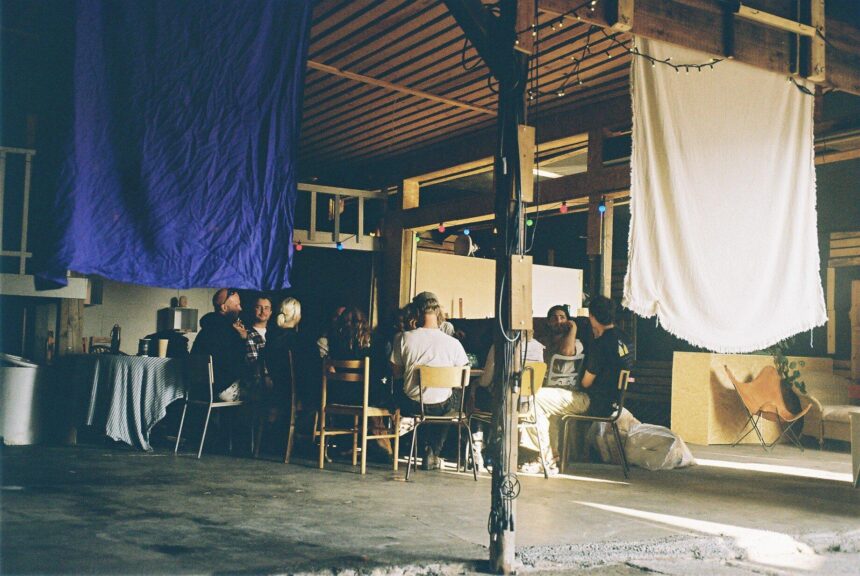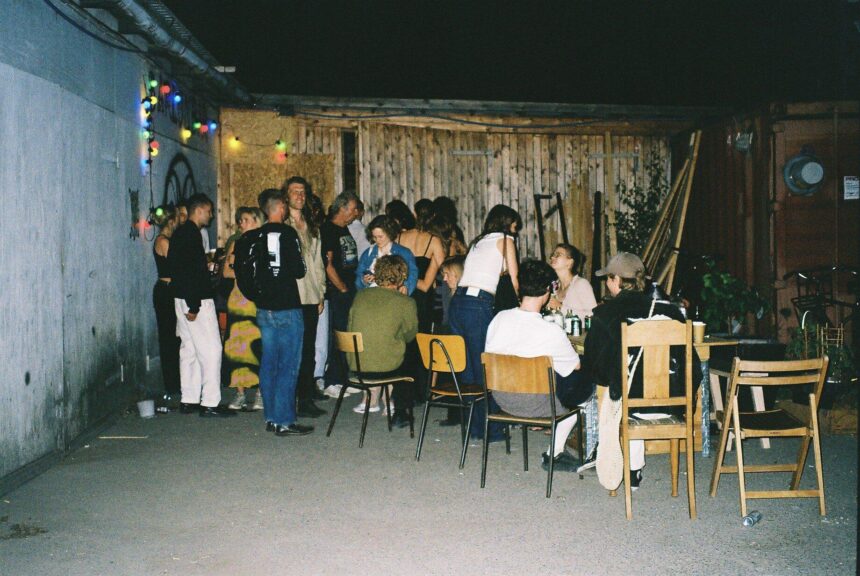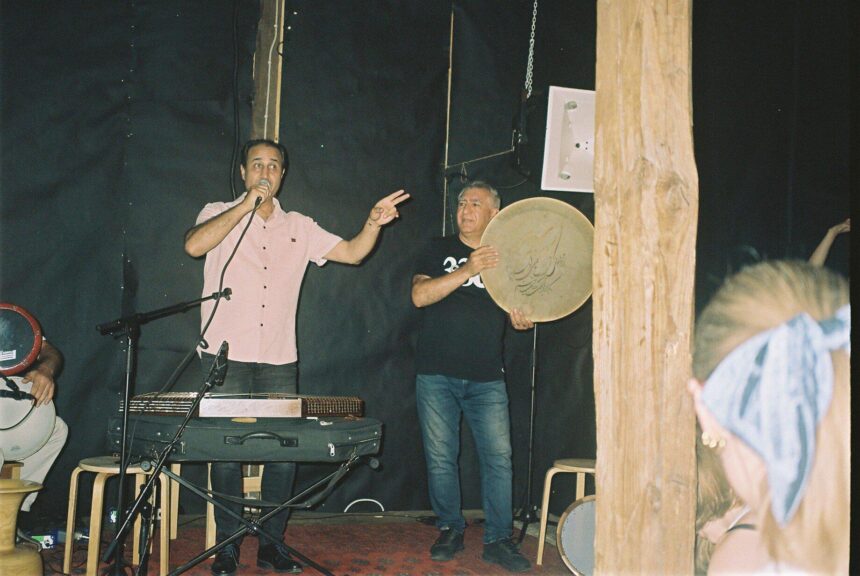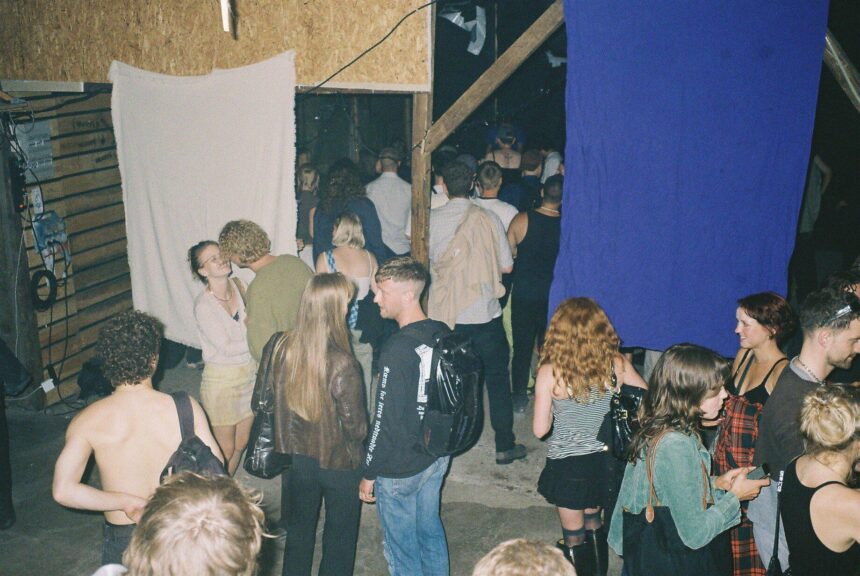Ny Lille Klub – Is there room for diverse venues in Copenhagen?

By Maite Cintron. Photos by Marie-Christin Henkelmann.
Earlier this year, the two independent venues Ny Lille Klub and Motopol closed down after apromixtaly a year. This led to many critical reflections about the conditions for smaller and non-commercial venues in Copenhagen and in which ways it might be possible to coorporate more fruitfully with the municipality about securing such spaces in the city’s cultural scene. In this interview, Maite Cintron sat down with two of the founders from Ny Lille Klub to discuss their view on the values of a venue like theirs and how similar initiatives can potentially be supported in the future.
The music scene in Copenhagen is growing into an increasingly diverse and experimental landscape, driven by an expanding cultural scene dedicated to redefining the intersections of music, politics and space. There is a growing number of experimental artists and collectives curating events that prioritize inclusive spaces for marginalized communities, both socially and economically. However, these artists and collectives are encountering a shortage of venues that align with their values, leading to inevitable competition for the limited spaces available in the city.
Most venues available in the city are hyper-commercialized or owned by larger companies as is the case with Rekom and NusNus. There have been efforts to create new spaces that aim to open up room for diverse and inclusive creative nightlife. One of these is the cultural house Ny Lille Klub, which was recently shut down in February this year from its venue at Laplandsgade. This occurred within the same month that neighboring music venue Motopol was also shut down, both of which continue making events and looking for new spaces in the city.

Last month, I sat down with two of the founding members behind Ny Lille Klub, Pouya Goran and Victor Tao Dinesen, for a conversation about the need for more DIY venues and their experience working with the municipality of Copenhagen.
The space of NLK was born out of a collective effort to create music and art events in Laplandskvarteret in Amager. The idea behind the venue and what drove its continuation was the desire to create a “clubhouse,” says Pouya. Instead of a nightclub, or concert venue, the clubhouse aimed to bring forward a new type of space for culture, art and dancing in Copenhagen. The purpose was to provide a platform for artistic diversity in a “cozy” space. One that welcomed continuous interaction between audiences, performers, and the NLK team beyond the prescribed dynamics at conventional music venues.
Their events were dynamic in their use of space as well as the arts that would be showcased in them. Using the available furniture, seating areas, dance floors and wardrobes took different shapes and forms at each event. Some of these included movie nights, concerts, a knitting club, poetry readings, a winter market, dj sets ranging from rock, to chill ambient music to techno events (and even a salsa, bachata and reggaeton event). Toward the end they also started the weekly Ny Lille Bodega, opening up the space as an informal bar on Thursdays for people to gather, as well as the classical concert series “Mellem Skyerne.”
“I also had my reservations at first, thinking “it’s far away. What if people don’t wanna come to Amager?” But of course they do. If it’s worth going.“
Victor Tao Dinesen
According to Victor, it was a “mess of success” with a lot of effort being put into organizing events, activities and fundraising to keep the place alive and establish it. There was “the desire for a place that wasn’t exclusive”. One that “wasn’t a cold and dark place.” Instead Victor recounts how they tried to create a warm atmosphere. “That’s been the keyword for Ny Lille Klub.” The space offered more than the individual escapism and entertainment that clubs usually offer, rather focusing on fostering a space of community through art. Luckily, the public was both interested and supportive of their efforts, with many people coming back as regulars to the venue.

“I also had my reservations at first, thinking “it’s far away. What if people don’t wanna come to Amager?” But of course they do. If it’s worth going. The positive thing as well is maybe if you have to go a little bit further, a little more isolated, you are more dedicated. I think that’s what we felt as well, people were very loyal”, Victor tells.
In Copenhagen there is a large, diverse music scene with many new artists and collectives surfacing. However, the lack of alternative venues becomes a hurdle for them to showcase their art and connect as a community with their audiences. Especially when it comes to venues that highlight community values over commercial interests. As a volunteer-based association NLK’s DIY structure aided in fostering this sense of community. Prices for events, membership and the bar were low in comparison to other nightlife venues in Copenhagen. People were driven to support the space as regular members, spontaneously helping during parties and sometimes formally, becoming part of the volunteer network.
NLK’s work is based on the idea that “you choose the amount of time and energy you want to dedicate to this place”. The increasing network of people supporting the venue only confirmed the local interest there was in maintaining such a cultural space. The different types of events also exemplified this communal effort as the space was open for anyone as a working member to ideate an event and be supported by the community to realize it. The venue thus became a dynamic cultural hub representative of the diversity in the city while also providing a safe space to enjoy art. The diverse art shared at the venue made NLK appealing to different audiences.

However, as most cultural spaces in Copenhagen, they also faced large obstacles to establish themselves. The city’s increasing rent prices and infrastructure regulations that limit the permits that can be obtained, makes it difficult to organize intimate events for experimental music and art along the lines of a venue such as NLK’s profile. Additionally, the long processing time for such bureaucratic processes for obtaining these permits or doing the necessary infrastructural changes to obtain them further threatens their economic survival. This was also the case of NLK, which in legal terms functioned as an association and not a commercial business. As an association aiming to do cultural events, their model and structuring of the organization differs to that of conventional and commercial venues. Consequently, these regulatory frameworks lack the flexibility to support their spaces. Still, other commercial venues around the city often also face similar challenges, including harsh noise regulations, even if located in more secluded areas outside of the city.
Although the venue was being supported by the municipality during its time at Laplandsgade, the venue was nonetheless shut down in the end, raising concerns on the planned environment for the area. In 2022, the municipality and Amager Øst Lokaludvalg published the document “Vision for Laplandskvarteret,” detailing the plans for the area based on conversations between local stakeholders such as landlords, residents and unions. In Danish, it was stated that
“The neighborhood’s buildings have value by virtue of the previous industrial history and spurs with its ‘rawness’ and flexibility for creative, flexible arrangements and many types of applications”*
The document highlights the already present artistic community in the area and the increased interest in developing the cultural sector by increasing the community spaces available. Additionally, the document recognizes the physical properties of the area’s buildings and their potential to function as multi-purpose creative spaces. The document also addresses the hurdles faced by local cultural workers in relation to renting these spaces for creative use. Here is where the built environment clashes with building- and cultural policies, as the cultural sector in planning incentivizes creative use of these spaces. However, infrastructure regulations impede these buildings from being used in new ways beyond their intended industrial purposes.

Now, in 2024, we have observed that these challenges and more are still present in the area with the closing of NLK as well as neighboring club Motopol. The presence of DIY spaces and their resurfacing in the area signals a continuous interest in having more multi-functional cultural spaces. As detailed in the municipality plan, this is in the interest of not just the cultural sector but also of the community and the municipality. It is important to address these planning discrepancies between the built and the planned environment in relation to the cultural sector.
Asking the NLK team in what ways they believe venues like theirs could be better supported, they reiterate the need for flexibility in policy. Examples of this include the incorporation of a committee designed to address temporary businesses and use policies based on the temporal models of businesses in order to maximize the potential of temporary spaces. Additionally, temporary policy frameworks for the adquisition of alcohol licenses and fire permits could also benefit cultural spaces in the early stages of establishing themselves. These venues are born from an experimental nature and as such should be supported by policy makers in a similar way. My conclusion from our interview is that better communication and changes in the regulatory frameworks in city planning are essential in order for Copenhagen to continue to cultivate spaces of diversity and artistic creativity.
With the heightened commercialization of cultural activities and spaces in Copenhagen, it is vital to support DIY venues in order to avoid a homogenous nightlife economy. As the challenges to find physical spaces for DIY venues in Copenhagen continue, the municipality should support these creative communities in locating suitable spaces. DIY approaches help diversify the nightlife sector by offering new economic and organizational models through which to experience culture. Addressing these spaces through their own regulatory framework would allow for the flexibility needed to accommodate these communal spaces in policy-making. As a new local plan for Laplandskvarteret is expected to be drafted for this year, reassessment on the cultural and building regulatory frameworks in the area is needed to support the existing remaining creative spaces.
Ny Lille Klub remains an active group creating events around the city while continuously looking for a new space. They continue to work with the municipality trying to regain a physical space in the city for the community. One can only hope that the municipality will soon recognise what initiatives like theirs help cultivate in the city.
* Own translation.
Note: The document “Vision for Laplandskvarteret” can be accessed here. Read Simin Stine Ramezanali’s previous interview with Ny Lille Klub here as well as Claus Haxholm’s and Mathias Schønberg’s concert reviews from the venue here and here.

